-
EngineTurbo 1.5L I3 + 96-kW Motor
-
Power362 HP / 420 LB-FT
-
Transmission6-Speed Auto + 2-Speed gearbox
-
0-60 Time4.2 Seconds
-
Top Speed155 MPH (Limited)
-
DrivetrainAll-Wheel Drive
-
Curb Weight3,285 LBS
-
Seating2+2
-
Cargo5.4 CU-FT
-
Base Price$135,700
Sleek sports-coupe design, carbon-fiber construction and blistering acceleration may cause automotive enthusiasts to drool, but the i8 has not been conceptualized, engineered or assembled to be another one of BMW's world-class track stars. Instead, the i8 has been hatched as a progressive sports car from the Bavarian outfit's new i division, which "represents visionary electric vehicles and mobility services, inspiring design and a new understanding of premium that is strongly defined by sustainability." Think of it as thrilling, but with an engaging environmental twist.
It's nearly impossible to walk up to the i8 without stopping twenty feet short and taking in its styling. There's no other production car as visually fascinating – this BMW is showroom-ready sculpture that captures all of the essence of the Vision Efficient Dynamics Concept that wowed crowds at the 2009 Frankfurt Motor Show. The wind sees it as a 0.26 drag coefficient, but humans will study its beautifully crafted carbon fiber and glass panels and realize they're in the presence of the future.
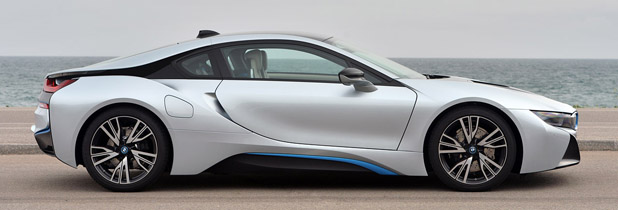
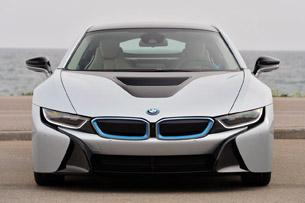
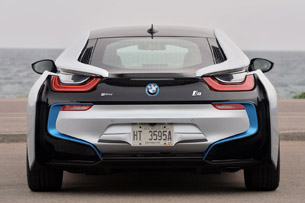
To keep weight to a minimum, BMW has chosen to build its i8 with an aluminum chassis that runs the length of the vehicle. Mounted atop the alloy structure is a carbon-fiber reinforced plastic (CFRP) passenger cell, which is covered in aluminum and composite body panels. The automaker has taken weight savings to the extreme by using foam plastic climate-control ducting (which also provides acoustic benefits), lightweight aluminum wiring (instead of copper), aluminum bolts and screws (instead of steel) and chemically hardened glass on the rear window that is thinner, lighter and more durable than its laminated equivalent. Hoist a showroom-ready i8 onto a scale and it weighs 3,285 pounds – about the same as a Honda Accord. That's rather impressive considering its complex powertrain.There's no other production car as visually fascinating – this BMW is showroom-ready sculpture
Butterfly doors add to the visual appeal, but as they lift up and away, they increase the effort required to drop into the passenger compartment, becoming useless as handholds to help clear the thick door sills. Ingress and egress is a leg-splayingly awkward affair (women in skirts and men in kilts will have to practice their boarding procedures). Once inside, the 2+2 cabin is remarkably comfortable for both driver and front passenger – I wouldn't put anyone in the tight back seats. The thin but well-padded bucket seats have been mounted on rails with generous travel, allowing my six-foot, two-inch frame the opportunity to be positioned comfortably with ample head, torso and shoulder room. The low, legs-out driving position is excellent.
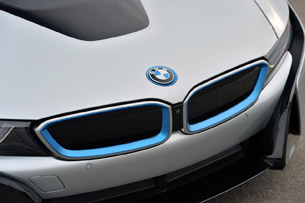
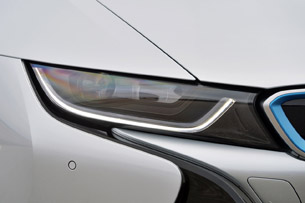
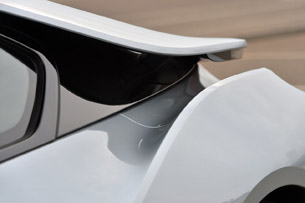
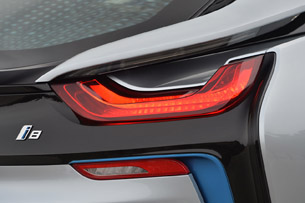
As one would expect, the i8's propulsion system is as unique as its exterior styling and construction – it essentially has two drivetrains. In the rear of the chassis is a 1.5-liter, direct-injected and turbocharged three-cylinder combustion engine, a tuned version of the powerplant also found in the new 2014 Mini Cooper. Mounted over the rear wheels and fed from an 11.1-gallon tank beneath the rear passenger seat, it's rated at 231 horsepower and 236 pound-feet of torque. The combustion engine is mated to a six-speed automatic gearbox driving only the rear wheels. At the front of the chassis is an electric motor, borrowed from BMW's i3 EV, rated at 96 kilowatts (129 horsepower) and 184 pound-feet of torque and mated to a two-stage gearbox exclusively driving the front wheels. Combine the two drivetrains, and total system output is 362 horsepower and 420 pound-feet of torque with through-the-road all-wheel drive. Fuel economy should be stellar, but BMW has yet to disclose any official numbers for the North American market.Combine the two drivetrains, and total system output is 362 horsepower and 420 pound-feet of torque with through-the-road all-wheel drive.
At startup, the i8 defaults to Comfort mode, which manages both motor and engine to provide a very good balance between sporty driving and strong fuel economy. Those seeking more range will toggle the Driving Experience Control switch to Eco Pro, while those wanting the liveliest driving experience will need to choose Sport. Lastly, the operator is able to run Comfort and Eco Pro purely in electric mode, providing five different driving choices.
In Comfort, and with a light-to-moderate accelerator foot, the i8 moves effortlessly as a front-wheel-drive electric vehicle. With an audible accompanying whine from the motor up front, the i8 is surprisingly quick off the line (it feels as if torque is deliberately rationed to prevent wheel spin at launch) and it pulls enthusiastically to cruising speeds. Despite being eight inches longer and five inches wider than a Porsche 911 Carrera, the i8 is agile and zippy through traffic – decidedly fun, even. Best of all, it will run up to 75 miles per hour in this configuration – meaning it's capable of handling all aspects of a daily commute, from city to highway, without taking a sip of gasoline.
Thanks to a refrigerant-cooled 5.2-kWh battery mounted on a rail in the aluminum chassis between the passengers, pure EV range is up to 22 miles. To replenish, the plug-in hybrid i8 can be recharged using a BMW iWallbox, a public charging station or at a wall outlet. At best, charge time is 1.5 hours from a 220-volt Level 2 charger. A 120-volt (12A) household circuit is capable of providing a charge in 3.5 hours.It's capable of handling all aspects of a daily commute, from city to highway, without taking a sip of gasoline.
BMW has nailed the driving position and the innovative use of recycled and environmentally friendly components within passenger compartment is awe inspiring, but all is not perfect in the i8's cabin. Build quality is exceptional and its advanced forward-looking ergonomics are very good (most of the switchgear locations are similarly shared with the rest of the automaker's models), but there is an overall lack of storage and poor outward visibly. The two cupholders are in the rear seating area, there are no door pockets because of their theatrical opening mechanisms, and only a small cubby or two (both too small for a mobile phone) within the driver's reach.
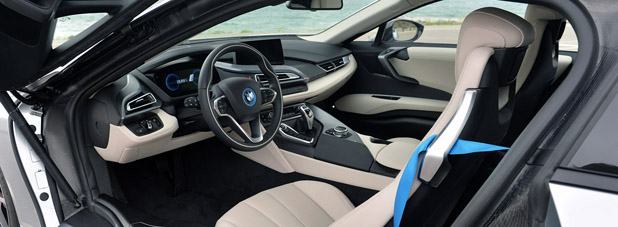
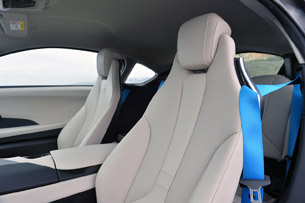
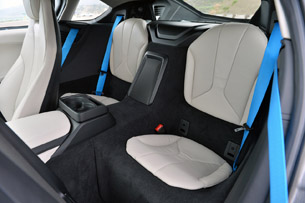
Outward visibility is unencumbered looking forward, but seriously hindered over each shoulder, as everything aft of the driver's ear is blocked by thick pillars or stylish wings. Lastly, the view through the innovative rear glass – the same material that is on the face of many smartphones – is slightly distorted. Thankfully, the exterior mirrors and a backup camera provide a better perspective of the world outside.
Slamming down the accelerator pedal while in Comfort awakens the rear-mounted combustion engine, which wrenches on the back wheels to provide additional thrust. Let off the accelerator, and it immediately goes back to sleep. Curiously enough, the 1.5-liter is nearly silent in this mode, requiring that the driver watch the visual display on the flat panel and listen acutely for its exhaust note – a whimper barely audible over the wind and tire noise. Its nearly silent soundtrack is the first of several reminders-by-omission that the i8 is not a product of BMW's M division.Its nearly silent soundtrack is the first of several reminders-by-omission that the i8 is not a product of BMW's M division.
Those seeking to optimize fuel economy will likely run i8 in Eco Pro with EV mode activated. The vehicle will then systematically exhaust its battery and switch to combustion power. As such, the vehicle operates in an "efficiency optimized" role, with non-essential electrical loads (e.g. air conditioning, heated seats, etc.) reduced to maximize range. Although life would be blissful driving the i8 in this mellow hypermiling configuration – spending hours waving at folks offering thumbs-up, taking pictures and showing praise upon BMW's excellent design – more challenging roads require all systems to be operating at 100 percent. BMW calls this Sport mode, and it's predictably my favorite of the five.
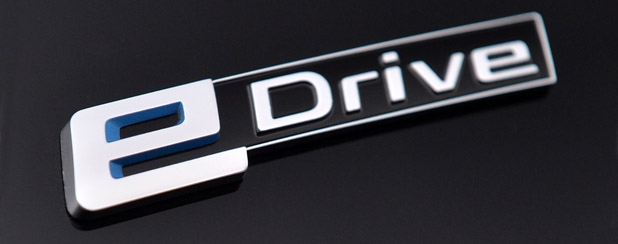
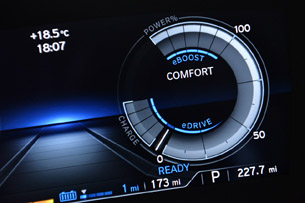
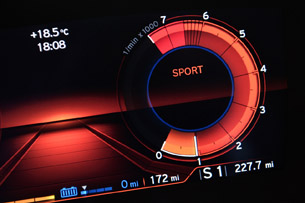
Sport, enacted by simply toggling the shift lever to the left, changes the i8's dashboard theme from a cool blue to a more urgent red, while immediately calling the combustion engine to duty. An unexpected – but pleasingly throaty – roar accompanies the engine. Three cylinders have never sounded so good, and that's at least partially because BMW engineers tell us that the powertrain music is a mixture of true exhaust sound and an augmented audio track playing through the cabin speakers. With the i8 now exposing more of its muscular and athletic side, I make a beeline towards the highway in search of more challenging roads.BMW is quoting a 0-60 sprint in about 4.2 seconds and an electronically limited top speed of 155 mph.
With both the motor and engine providing thrust, the i8 is a space-age rocketship. BMW is quoting a 0-60 sprint in about 4.2 seconds and an electronically limited top speed of 155 mph (accomplished under propulsion from both powerplants), and driving yields no reason to doubt those numbers - it is very quick. Power delivery appears to be deliberately regulated to available grip, so it launches slowly (no wheelspin) and then abruptly picks up speed. The smooth little 1.5-liter triple works beautifully with its automatic gearbox, snapping off rapid upshifts and blipping the throttle on the way back down. Credit the engine's very low rotating mass with its impeccably quick response.
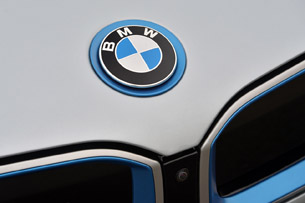
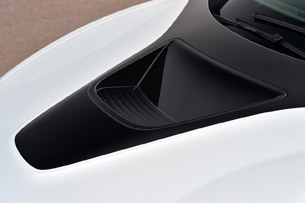
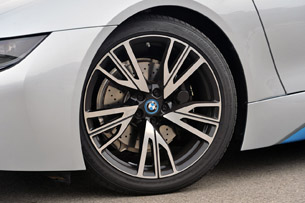
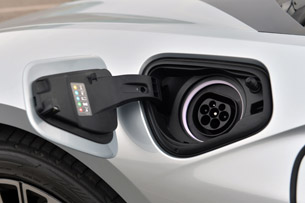
Bolted to the aluminum chassis is a double-track control arm front axle and a five-link rear axle – aluminum alloy is used extensively to keep weight to a minimum. The dampers are electronically adjustable (BMW's Dynamic Damper Control) based on the selected driving mode. Stopping is tasked to disc brakes at all four corners (four piston calipers up front, with single piston calipers in the rear), with a regenerative system to recover kinetic energy under deceleration. I was taken aback by the pedal feel, which is too springy for my taste, but the regenerative system is integrated seamlessly.
The i8's construction is unlike any other BMW, and its ride is, too. Its comportment is firm, even with the dampers in their softest setting, but the chassis is so stiff that unexpected harsh impacts or bumps don't unsettle it – wheels encounter impacts and then immediately move to their next tasks. Overall, the cabin is quiet at speed. Wind noise on the highway is low, with subtle tire noise being the most obvious offender (an optional 280-watt Harman Kardon audio upgrade will easily staunch the din).The i8 pulls strongly, with the sweetly audible soundtrack of the combustion engine complementing the g-forces pressing me into the seat.
Turning off the highway, it's time to nudge the transmission selector back into Sport for a climb into the mountains. The i8 pulls strongly, with the sweetly audible soundtrack of the combustion engine complementing the g-forces pressing me into the seat. Actuating the steering wheel-mounted paddles effectively cracks off gear after gear, with lightning speed, with a snarl from the back end as each ratio is engaged. I take the first few corners cautiously and then start to push the BMW harder and harder.
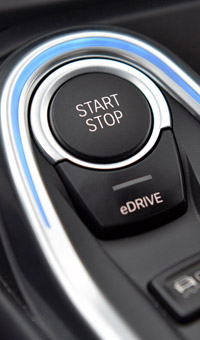
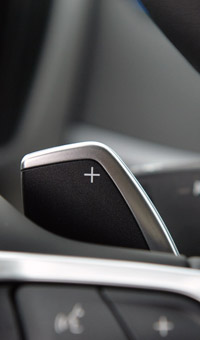
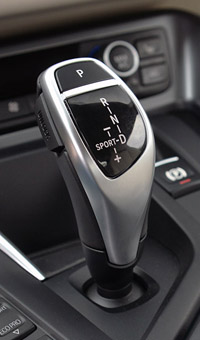
As is the case with all vehicles, higher speeds and more aggressive driving tends to reveal issues that otherwise go unnoticed. Throttle response, which felt quick around town, suddenly feels slightly delayed – there's a brief, tenth-of-a-second pause as the computers calculate at which end to apply the power. Feedback from the steering wheel, which had felt good around town, also comes across as less communicative – especially as more steering angle is dialed in – and turn-in loses some of its sharpness. The i8's platform continues to be nicely balanced and offer flat cornering (it boasts a 50/50 weight distribution and a center of gravity just 18 inches off the pavement), but it understeers heavily as the front tires quickly become overworked.Despite their "ultra-high performance" designation from the manufacturer, the tires are simply too narrow for a sports car role.
Choosing wheels and tires is a delicate compromise between aerodynamics, rolling resistance, weight and ultimate grip. The i8's standard tire fitment pairs lightweight forged 20-inch alloys at all four corners with 195/50R20 tires up front and 215/45R20 tires in the rear. Thankfully, my test car arrived wearing optional – and marginally wider – Bridgestone Potenza S001 tires, sized 215/45R20 front and 245/40R20 rear (BMW will not use run-flat tires on this model – huzzah!). Despite their "ultra-high performance" designation from the manufacturer, they are simply too narrow for a sports car role – especially those tasked with holding the coupe's shapely nose on the proper line. At just such a moment, mid-corner in a canyon run, with arms dialing-in far more steering that the front wheels are delivering, the driver is again reminded that the i8 is not a product of BMW M. Truth is, an M6 would laugh off the identical challenge. And do it on cold rubber.
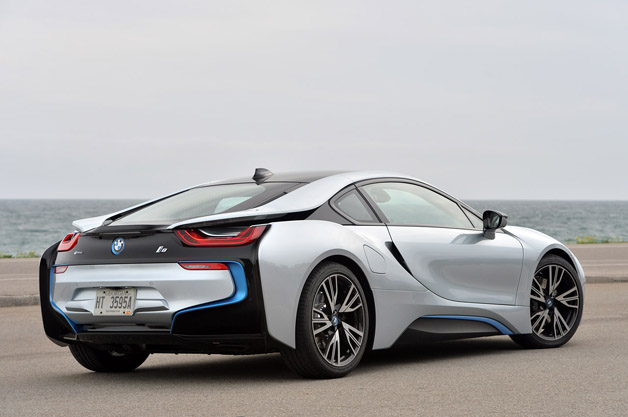
Not a single person at BMW's i division would so much as blink when I later question them about this car's tires. Each smiled and reminded me that the i8 has been executed almost exactly as originally planned, and that the letter M never came up during its development – i models reside at the other end of BMW's lineup, with the standard models occupying the space between. The team's mission was not to build a new flagship sports coupe, but to design a "distinctly forward-looking and sustainability-focused sports car" that provides a "revolutionary interpretation of BMW's hallmark driving pleasure."The green movement may have just found its provocative new sweetheart.
Focused on that mission, I believe that the engineering team at BMW's i division has nailed it. Even though the BMW i8 doesn't really break any new ground in terms of hybrid innovation or set new fuel-efficiency records, the aluminum and carbon-fiber coupe is a stunning leap forward in terms of build construction, powertrain integration, overall driveability and styling. Each of its minor shortcomings are overshadowed by its sensually sculpted lines, and its real-world performance – the manner in which most owners will actually drive it – is engaging and very enjoyable.
While conventional high-end sports coupes need not fret about the i8, a warning goes out to the Tesla Model S – the green movement may have just found its provocative new sweetheart.










Sign in to post
Please sign in to leave a comment.
Continue